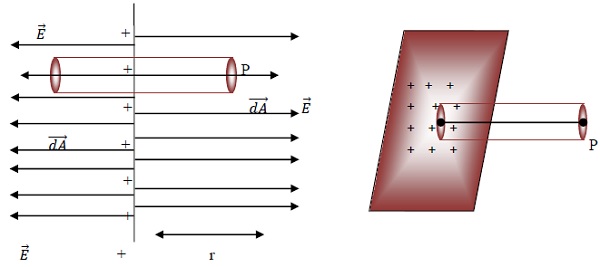Electric Field Due to Infinite Large Sheet of Charge
Description:
Let there be an infinitely long sheet in which charges are uniformly distributed and we are supposed to find electric field at a certain distance ‘r’ at point ‘P’ using Gauss Theorem.
We know that if the charge distribution is over a sheet then we use areal charge density (σ) to find the electric field.
Step 1
We take a cylindrical Gaussian surface of radius ‘r’ and length ‘l’, Whose axis is normal to the sheet and point ‘P’ lies on the flat surface. as shown in figure. E is radial (perpendicular to charged surface) is symmetrical at every point of flat surface. Area vector (A→) makes an angle 0. With electric field (E→) At every point on the flat surface.

For sheet of charge, divide the Gaussian surface into two surfaces so that each surface has separate symmetry.
Electric field at every point on the flat surface is 0o, whereas at every point on curved surface is 90o. Hence both the surface makes a perfect symmetry.
Step 2
If there are more than one symmetry the calculation of electric flux is done separately for each surface and all are then added up to get total electric flux.
Φ = ∮ E→.dA→ = ∮ EdScosθ
⇒ Φ = ∮ EdScos 90 + ∮ EdScos 0 + ∮ EdScos 0
⇒ Φ = E∮ dS + E ∮ dS (For both the flat surfaces the E→and A→ are in the same direction)
Let the total area be A.
Therefore; ∮ dS = A
Φ = EA + EA
Φ = 2EA
Step 3
Charge on 1m2 = σ
So charge on A m2 = Aσ
Charge within the surface = Aσ
Step 4
Apply Gauss Theorem −
∮ E.dS = q/ ε0
Putting values in the equation we get −
2EA = Aσ/ εo
So, E = σ2ε0

